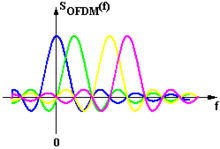Orthogonal frequency-division multiplexing
method of encoding digital data on multiple carrier frequencies
(Redirected from Orthogonal Frequency Division Multiplexing)
Orthogonal Frequency Division Multiplexing is a technology related to Frequency Division Multiplexing. With it, many different signals can be sent over the same medium, at the same time. Each signal uses a different basis function. By using the basis function given, the sender and recipient will then see their signal better, the other signals will be clearly separated.

Advantages and disadvantages
changeAdvantages
change- Can adapt easily to bad channels (noisy,etc.)
- Robust against crosstalk between channels that are close together.
- Robust against Intersymbol interference (ISI) and fading caused by multipath propagation
- High spectral efficiency
- There are good implementations available
- Few problems with errors that come from time synchornization
- Tuned sub-channel receiver filters are not required (unlike conventional FDM)
- Facilitates Single Frequency Networks, i.e. transmitter macrodiversity.
Disadvantages
change- Problems with Doppler shift.
- Synchronizing frequencies can be problematic
- Sensitive to frequency synchronization problems.
- High peak-to-average-power ratio (PAPR). This needs linear transmission circuits; they need a lot of power.
- Loss of efficiency caused by Cyclic prefix/Guard interval
Uses
changeMany technologies use OFDM. Among them are:
- ADSL and VDSL
- Power line communication
- Wireless LAN, namely 802.11a,g, and n, and HiperLAN/2 (802.11b uses Direct-sequence spread spectrum)
- 4G LTE mobile networks use OFDMA (OFDM multi-users variant)
- Some Digital radio systems
- Some Digital TV systems, most notably DVB-T